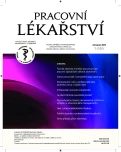Quality of life in patients with vertigo
Authors:
Vyskotová Jana 1; Mrázková Eva 2,3; Sachová Petra 2; Richterová Kateřina 2; Baarová Šárka 3; Bužgová Radka 4; Hajduková Zdeňka 3
Authors‘ workplace:
Katedra rehabilitace
vedoucí doc. MUDr. Leopold Pleva, CSc.
1; Ústav epidemiologie a ochrany veřejného zdraví, Lékařská fakulta Ostravské univerzity
vedoucí prof. MUDr. Vladimír Janout, CSc.
2; Klinika pracovního a preventivního lékařství, Fakultní nemocnice Ostrava
přednosta MUDr. Zdeňka Hajduková, Ph. D.
3; Ústav ošetřovatelství a porodní asistence Lékařská fakulta Ostravské univerzity
vedoucí doc. PhDr. Darja Jarošová, Ph. D.
4
Published in:
Pracov. Lék., 65, 2013, No. 1-2, s. 25-31.
Category:
Original Papers
Overview
Objective:
The objective of the work was to compare quality of life of the respondents with or without vertigo (with chronic occupational disease) and to compare the data with a population standard using standard questionnaires.
Method:
The respondents at the age of 18 to 65 years were divided into three groups – a group of patients with vertigo, another group without vertigo and a group of healthy individuals. The group of patients with vertigo encompassed 54 patients, 42 women and 12 men. The group of patients with vertigo, who suffered from chronic occupational diseases, included 24 probands, 14 of them being women and 10 men. The group of healthy individuals encompassed 308 probands. The research was made by means of an anonymous questionnaire survey. The questionnaire WHOQOL – BREF of the World Health Organization consisting of 26 questions altogether was used to evaluate the quality of life. In order to compare the results reached with a healthy population, the authors used a population standard (a common population) adopted from the User’s (Instruction) Manual for the WHOQOL questionnaire. For the determination of handicap associated with vertigo symptoms the authors used the Dizziness handicap inventory questionnaire (DHI) which includes 25 items and 3 reaction levels. It evaluates the impact of vestibular disorder on the patient’s personality with respect to physical, psychical and emotional aspects in common daily activities.
Results:
The respondents with vertigo displayed a lower score in the “Physical health” domain as compared with respondents without vertigo and with the population standard. The “Living out” domain was evaluated by the respondents without vertigo in a similar way as the healthy population. The “Social Relations” domain was evaluated as the best by the respondents without vertigo. The “Environment” domain was evaluated as the best by the respondents without vertigo. The respondents who suffered from vertigo reported deteriorated quality of life as compared with respondents without vertigo and the common population. The matter of satisfaction with health was considered worst by respondents with vertigo as compared with the control group of respondents without vertigo and the control group of healthy probands. In addition to quality of life, the 54 respondents with vertigo also evaluated the DHI questionnaire, which is concerned with complaints the respondents experience in emotional, physical and psychical area. As many as 78% pf patients with balance disorders in the DHI questionnaire had no handicap in the emotional area. A light handicap was recorded in 22% of respondents. Vertigo represents a disadvantage for the patients and negatively influences the psychical area as well. Twenty four percent of our respondents experienced this kind of handicap. They considered their physical handicap as light in 37%, medium in 24% and severe is 13% and it 26% of the patients with vertigo suppose this handicap could become manifested in further course of the disease.
Conclusion:
The DHI questionnaire appears to be a suitable tool for the determination of severity of vertigo and its perception by the patients. It makes it possible to objectify the otherwise impalpable and hardly quantifiable subjective perception of vertigo. In this way the questionnaire may become a useful supplementary tool to objective methods of examination, diagnostics, therapy and a long-term follow-up of patients with vertigo.
Keywords:
vertigo – quality of life – WHOQOL – BREF – Dizziness handicap inventory (DHI)
Sources
1. Ambler, Z., Jeřábek, J. Diferenciální diagnostika závratí. Praha: Triton, 2001.
2. Černý, R., Jeřábek, J., Bojar, M. Vertigo a poruchy rovnováhy v ordinaci praktického lékaře I. Bulletin sdružení praktických lékařů ČR, 2008, 5, s. 31–43.
3. Dragomirecká, E., Bartoňová, J. Příručka pro uživatele české verze dotazníku kvality života Světové zdravotnické organizace. Praha: Psychiatrické centrum, 2006.
4. Gurková, E. Hodnocení kvality života pro klinickou praxi a ošetřovatelský výzkum. Praha: Grada, 2011.
5. Jacobson, G. P., Newman, C. W. The development of the Dizziness Handicap Inventory. Arch. Otolaryngol. Head Neck Surg., 1990,116, s. 424–427.
6. Křivohlavý, J. Psychologie zdraví. Praha: Portál, 2009.
7. Novotný, M. Vertigo. Postgraduální medicína, 2007, 9 (8), s. 946–951.
8. Patatas, O. H. G., Gananca, C. F., Gananca, F. F. Quality of life of individuals submitted to vestibular rehabilitation. Braz. J. Otorhinolaryngol., (Impr.) [online]. 2009, 75 (3), s. 387–394. ISSN 1808-8694. Dostupný z www:
http://dx.doi.org/10.1590/S1808-86942009000300014.
Labels
Hygiene and epidemiology Hyperbaric medicine Occupational medicineArticle was published in
Occupational Medicine

2013 Issue 1-2
Most read in this issue
- Compensation exercise in patients with occupational lesion of ulnar nerve in the elbow region
- Focal dystonia in professional musicians
- Psychohygiene (not only) as prevention of the burn-out syndrome in medical management
- Does liver fibrosis represent a reversible process?
